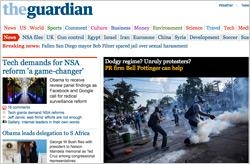'Guardian' Plans More NSA Stories
- by Erik Sass @eriksass1, December 9, 2013

Expect to see more pieces on the NSA’s surveillance of online communications -- but maybe not quite as many as one might expect. That's in light of the recent statement by the Guardian’s U.K. editor, Alan Rusbridger, that over 99% of the files have yet to be published.
Rusbridger’s statement triggered an outcry last week from freedom of information activists who voiced fears that
the Guardian is backing down in the face of government pressure.
But Janine Gibson, the Guardian’s U.S. editor in chief, who first fielded the story from
Guardian reporter Glenn Greenwald, noted: “When we say we have only published 1% of the documents, that doesn’t mean the other 99% of the documents tell a story that would be
sufficiently in the public interest to be worth publishing.”
advertisement
advertisement
That said, Gibson confirmed there are definitely more stories on the way: “We have been consistently and steadily publishing stories now for several months. We’re taking our time and doing it carefully.”
In this situation, it’s easy to imagine the U.S. government as a wrathful Big Brother, determined to squash its critics. But interestingly, Gibson observed that when it comes to querying officialdom, “the U.S. First Amendment culture means we’ve been able to conduct this conversation in a much more open and mature way. Officials respond here; we’ve had over 100 contacts with the White House” during the course of the investigation. By contrast, there was “rather more of a chill in the U.K. There is a definitely a sense that the Guardian is being investigated. But that’s not going to stop us.”
There’s no question that the NSA has raised the Guardian’s profile in the
U.S., but the scoop is just part of a larger, long-term growth strategy in this country, with a heavy emphasis on new approaches to publishing enabled by digital media.
Examples include
the live “GIF”-ing of the 2012 presidential debates in partnership with Tumblr, which delivered substantive summaries of the candidates’ positions mixed with some much-deserved,
British-inflected irreverence, as well as an interactive graphic novel telling the story of the election. That British irreverence -- call it “cheekiness” -- comes through in plenty of
other ways, too.
In the weeks leading up to the birth of Prince George, the Guardian Web site offered a “baby toggle,” allowing readers with no interest in the royal
spawning to turn off all baby-related news.
The Guardian U.S. has also created an immersive, experiential presence in the form of the #GuardianGreenRoom, a digital lounge space housed at Rough Trade’s new retail outlet in Williamsburg, Brooklyn, where visitors can explore the Guardian's music and cultural coverage, engage with a variety of interactive content, and generally revel in the hip milieu.
On the advertising front, the company is bringing “Guardian Labs,” a new custom sponsorship service for advertisers, to the U.S. Examples of the
company’s branded partnerships back in the U.K. include GuardianWitness, a user-generated content platform created in collaboration with EE, the largest mobile service provider in the U.K.
The company hired Jason Kleinman, formerly of The New York Times’ Idea Lab, to lead custom marketing initiatives. In recent months the Guardian also enlisted Carter Brokaw,
formerly CRO at Slacker, as executive vice president for sales.


